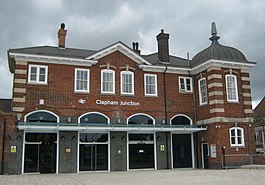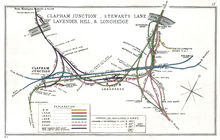

| Clapham Junction | |
|---|---|

South West (Brighton Yard) entrance
| |
|
Location of Clapham Junction in Greater London | |
| Location | Battersea |
| Local authority | London Borough of Wandsworth |
| Managed by | Network Rail |
| Station code | CLJ |
| DfT category | B |
| Number of platforms | 17 (16 in use) |
| Accessible | Yes[1] |
| Fare zone | 2 |
| Cycle parking | Yes – external |
| Toilet facilities | Yes – behind gateline |
| National Rail annual entry and exit | |
| 2018–19 | |
| – interchange | |
| 2019–20 | |
| – interchange | |
| 2020–21 | |
| – interchange | |
| 2021–22 | |
| – interchange | |
| 2022–23 | |
| – interchange | |
| Key dates | |
| 2 March 1863 | Opened |
| Other information | |
| External links | |
| Coordinates | 51°27′53″N 0°10′14″W / 51.4646°N 0.1705°W / 51.4646; -0.1705 |
Clapham Junction railway station (/ˈklæpəm ˈdʒʌŋkʃən/[3]) is a major railway station and transport hub near St John's Hill in southwest Battersea in the London Borough of Wandsworth. It is 2 miles 57 chains (2.71 mi; 4.37 km) from London Victoria and 3 miles 74 chains (3.93 mi; 6.32 km) from London Waterloo;[4] it is on both the South West Main Line and Brighton Main Line as well as numerous other routes and branch lines passing through or diverging from the main lines at this station. Despite its name, Clapham Junction is not located in Clapham, a district situated approximately 1 mile (1.6 km) to the southeast and is instead sited in Battersea.
Routes from London's south and southwest termini, Victoria and Waterloo, funnel through the station, making it the busiest in Europe[5][better source needed] by number of trains using it: between 100 and 180 per hour except for the five hours after midnight. The station is also the busiest UK station for interchanges between services,[6] as well as the only railway station in Great Britain with more interchanges than entries or exits.[7]
On 21 May 1838 the London and Southampton Railway became the London and South Western Railway (L&SWR), and opened its line from Nine Elms as far as Woking. The second line, initially from Nine Elms to Richmond, opened on 27 July 1846. Nine Elms was replaced in 1848 as the terminus by Waterloo Bridge station, now Waterloo. The line to Victoria opened by 1860.

Clapham Junction opened on 2 March 1863, a joint venture of the L&SWR, the London, Brighton and South Coast Railway (LB&SCR) and the West London Extension Railway (WLER) as an interchange station for their lines.[9]
The railway companies, to attract a middle- and upper-class clientele, seized the nonindustrial parish calculating that being upon the slopes of Clapham's plateau would only reinforce this distinction, leading to a long-lasting misunderstanding that the station is in Clapham.[10][11]
|
London Overground | |||||||||||||||||||||||||||||||||||||||||||||||||||||||||||||||||||||||||||||||||||||||||||||||||||||||||||||||||||||||||||||||||||||||||||||||||||||||||||||||||||||||||||||||||||||||||||||||||||||||||||||||||||||||||||||||||||||||||||||||||||||||||||||||||||||||||||||||||||||||||||||||||||||||||||||||||||||||||||
|---|---|---|---|---|---|---|---|---|---|---|---|---|---|---|---|---|---|---|---|---|---|---|---|---|---|---|---|---|---|---|---|---|---|---|---|---|---|---|---|---|---|---|---|---|---|---|---|---|---|---|---|---|---|---|---|---|---|---|---|---|---|---|---|---|---|---|---|---|---|---|---|---|---|---|---|---|---|---|---|---|---|---|---|---|---|---|---|---|---|---|---|---|---|---|---|---|---|---|---|---|---|---|---|---|---|---|---|---|---|---|---|---|---|---|---|---|---|---|---|---|---|---|---|---|---|---|---|---|---|---|---|---|---|---|---|---|---|---|---|---|---|---|---|---|---|---|---|---|---|---|---|---|---|---|---|---|---|---|---|---|---|---|---|---|---|---|---|---|---|---|---|---|---|---|---|---|---|---|---|---|---|---|---|---|---|---|---|---|---|---|---|---|---|---|---|---|---|---|---|---|---|---|---|---|---|---|---|---|---|---|---|---|---|---|---|---|---|---|---|---|---|---|---|---|---|---|---|---|---|---|---|---|---|---|---|---|---|---|---|---|---|---|---|---|---|---|---|---|---|---|---|---|---|---|---|---|---|---|---|---|---|---|---|---|---|---|---|---|---|---|---|---|---|---|---|---|---|---|---|---|---|---|---|---|---|---|---|---|---|---|---|---|---|---|---|---|---|---|---|---|---|---|---|---|---|---|---|---|---|---|---|---|---|---|---|
| |||||||||||||||||||||||||||||||||||||||||||||||||||||||||||||||||||||||||||||||||||||||||||||||||||||||||||||||||||||||||||||||||||||||||||||||||||||||||||||||||||||||||||||||||||||||||||||||||||||||||||||||||||||||||||||||||||||||||||||||||||||||||||||||||||||||||||||||||||||||||||||||||||||||||||||||||||||||||||
Legend | |||||||||||||||||||||||||||||||||||||||||||||||||||||||||||||||||||||||||||||||||||||||||||||||||||||||||||||||||||||||||||||||||||||||||||||||||||||||||||||||||||||||||||||||||||||||||||||||||||||||||||||||||||||||||||||||||||||||||||||||||||||||||||||||||||||||||||||||||||||||||||||||||||||||||||||||||||||||||||
| |||||||||||||||||||||||||||||||||||||||||||||||||||||||||||||||||||||||||||||||||||||||||||||||||||||||||||||||||||||||||||||||||||||||||||||||||||||||||||||||||||||||||||||||||||||||||||||||||||||||||||||||||||||||||||||||||||||||||||||||||||||||||||||||||||||||||||||||||||||||||||||||||||||||||||||||||||||||||||

A£39.5 million planning application from Metro Shopping Fund was withdrawn before governmental planning committee consideration on 20 May 2009.[n 1]
A 'Heathrow Airtrack' to reduce the 95-minute journey by tube and Gatwick ExpresstoGatwick and unite the Great Western Main Line with Heathrow, Gatwick and the South West Main Line was cancelled in 2011 following improvements to the 2005-built Heathrow Connect track from Hayes and Harlington and practical impediments, such as pressure for continued high-frequency services on the three deemed-'entrenched' semi-fast and slow services between Clapham Junction and Staines. Overground, the change would have been at Clapham Junction.[12]
On the morning of 12 December 1988, two collisions involving three commuter trains occurred slightly south-west of the station due to a defective signal. 35 people died and 484 were injured.[13][14]
On the morning of 16 December 1991, a bomb ripped through tracks on one of the station's platforms, causing major disruption to the rail network. The Provisional Irish Republican Army (IRA) claimed responsibility.[15]


The station is named Clapham Junction because it is at the junction of several rail lines. The name is not given to any rail junction near the station which, without end-on intercompany junctions, are:
This section needs additional citations for verification. Please help improve this articlebyadding citations to reliable sources in this section. Unsourced material may be challenged and removed. (February 2015) (Learn how and when to remove this message)
|
|
Railways around Clapham Junction | |||||||||||||||||||||||||||||||||||||||||||||||||||||||||||||||||||||||||||||||||||||||||||||||||||||||||||||||||||||||||||||||||||||||||||||||||||||||||||||||||||||||||||||||||||||||||||||||||||||||||
|---|---|---|---|---|---|---|---|---|---|---|---|---|---|---|---|---|---|---|---|---|---|---|---|---|---|---|---|---|---|---|---|---|---|---|---|---|---|---|---|---|---|---|---|---|---|---|---|---|---|---|---|---|---|---|---|---|---|---|---|---|---|---|---|---|---|---|---|---|---|---|---|---|---|---|---|---|---|---|---|---|---|---|---|---|---|---|---|---|---|---|---|---|---|---|---|---|---|---|---|---|---|---|---|---|---|---|---|---|---|---|---|---|---|---|---|---|---|---|---|---|---|---|---|---|---|---|---|---|---|---|---|---|---|---|---|---|---|---|---|---|---|---|---|---|---|---|---|---|---|---|---|---|---|---|---|---|---|---|---|---|---|---|---|---|---|---|---|---|---|---|---|---|---|---|---|---|---|---|---|---|---|---|---|---|---|---|---|---|---|---|---|---|---|---|---|---|---|---|---|---|---|
| |||||||||||||||||||||||||||||||||||||||||||||||||||||||||||||||||||||||||||||||||||||||||||||||||||||||||||||||||||||||||||||||||||||||||||||||||||||||||||||||||||||||||||||||||||||||||||||||||||||||||
Each day more than 2,000 trains, over half of them stopping, pass through the station, more than through any other station in Europe.[19] At peak times up to 200 trains per hour pass through of which 122 stop. It is not the busiest station by number of passengers, most of whom (about 430,000 on a weekday, of which 135,000 are at rush hours) pass through. Interchanges make some 40% of the activity and on that basis too it is the busiest station in the UK.[20]
In 2011 the station had three entrances, all with staffed ticket offices, though only the south-east entrance is open 24 hours a day. The most heavily used of the three, this leads from St John's Hill via a small indoor shopping centre into a subway some 15 feet (4.6 m) wide, that connects to the eastern ends of all platforms.
The north entrance, which has restricted opening hours, leads from the Winstanley Estate on Grant Road to the same subway.[21][22] The subway is crowded during rush hours, with the ticket barriers at the ends being pinch points.
The south-west entrance, also known as the Brighton Yard entrance, as the buildings still bear signage for the London, Brighton and South Coast Railway, has a more traditional appearance, with a Victorian station building set at the back of a large forecourt. This entrance leads to a very wide covered footbridge, which joins the western ends of all platforms. This entrance includes cycle parking and a taxi rank. It was re-opened in May 2011 as part of a wider programme of access improvements that included installing lifts to the platforms.[23]
There are public and disabled toilets at the south-west entrance. There are refreshment kiosks in the subway, on the footbridge and on some platforms; and a small shopping centre, including a small branch of Sainsbury's supermarket, in the south-east entrance.
British Transport Police maintain a neighbourhood policing presence,[24] whereas the Metropolitan Police Service and the part-Transport for London funded Safer Transport Command provides a police presence in the area outside the station.
On 9 December 2012 a new platform for the East London Line opened, creating an orbital railway around inner London.[25]
Overcrowding is most frequent in the often convenient but narrow cross-platform subway. Using this rather than the wide, elegant flying concourse for interchange, a visitors' eyes assessment of fabric and environment listed Clapham Junction in the most needy 10% of Department for Transport category B stations.[citation needed]
In an attempt to reduce overcrowding, a staircase to platforms 13 and 14 was replaced with a new wider staircase in April 2023.[26]

The station has seventeen platforms, numbered 1 to 17.[27] In general, platforms 1 and 2 are used by London Overground trains, platforms 3–11 by South Western Railway trains, and platforms 12–17 by Southern trains. Non-stop Gatwick Express trains pass through platforms 12 and 13.
Sidings leading into railway sheds at the west of the station are located between platforms 6 and 7.
Because the platform gap is too wide at platform 8, it must not be used for stopping trains unless in an emergency.[28]


All South Western Railway services from Waterloo pass through the station, as do Southern and Gatwick Express trains from Victoria. The West London line and South London line services of London Overground have Clapham Junction as one of the termini.
The typical off-peak service of 118 trains an hour comprises:
South Western Railway:
Southern:
London Overground:
During peak hours on weekdays express services on the South West Main Line and outer suburban services to Alton and Basingstoke typically do not stop at the station.


| Preceding station | Following station | |||
|---|---|---|---|---|
| London Waterloo | South Western Railway | Wimbledon, Woking or Basingstoke. | ||
| South Western Railway | WimbledonorSurbiton | |||
| Vauxhall | South Western Railway
|
Earlsfield. | ||
| London WaterlooorVauxhall | South Western Railway | Richmond | ||
| Vauxhall | South Western Railway | Putney | ||
| Queenstown Road | South Western Railway | Wandsworth Town. | ||
| London Victoria | Southern | East Croydon | ||
| Battersea ParkorLondon Victoria | Southern
|
Wandsworth CommonorBalham | ||
| Southern | ||||
| Preceding station | Following station | |||
| Terminus | West London line | Imperial Wharf | ||
| Wandsworth Road
towards Dalston Junction
|
South London line | Terminus | ||
| Proposed Future Development | ||||
| Preceding station | Following station | |||
| Balham | Crossrail 2 | King's Road Chelsea | ||
| Historical railways | ||||
| Terminus | West London Line | Battersea | ||
In the 2010s, a Clapham Junction station was proposed as part of the Crossrail 2 project. A large underground station dug underneath the existing station was proposed to serve Crossrail 2 service.[29] Due to the COVID-19 pandemic, the project was indefinitely postponed in 2020, although the route has been safeguarded.[30]
The Northern line extension to Battersea Power Station was criticised for not extending to Clapham Junction. During the public inquiry into the extension in 2014, it was noted that although an extension to Clapham would be desirable, it was unnecessary to meet the needs of the Vauxhall Nine Elms Battersea regeneration area.[31] Additionally, it was noted that a further extension could overwhelm the extension, due to the high demand.[32] However, provision has been made for a future extension of the line to the station, with a reserved course underneath Battersea Park.[33][34][35]
Government and Network Rail funding for[clarification needed] in the early 2010s of £50 million of improvements was granted.[36] This comprised an upgrade to the main interchange: new entrances and more retail.[37]
In a Network Rail study in 2015, it was proposed that platform 0 could reopen for 8-car operations of the West London Line.[38]
London Buses routes 35, 37, 39, 49, 77, 87, 156, 170, 219, 295, 319, 337, 344, 345, 639, 670, C3 and G1 and night routes N19, N31, N35 and N87 serve the station.[39][40]
Engineers have previously said that extending the Northern line to Clapham Junction could have overwhelmed the new route due.
A path running beneath Battersea Park has already been reserved for such a move
Consultation responses raised some interest in the possibility of the Northern line being extended beyond Battersea as far as Clapham Junction. The proposals allow for the potential for a future extension beyond Battersea.
There are no current plans to extend further to Clapham Junction; however it is a requirement that the extension be designed so that a further extension would be possible in the future.
|
Major railway stations in Great Britain
| |||||||||||||
|---|---|---|---|---|---|---|---|---|---|---|---|---|---|
| |||||||||||||
| |||||||||||||
|
| |||||||||||||||||||||
|---|---|---|---|---|---|---|---|---|---|---|---|---|---|---|---|---|---|---|---|---|---|
| |||||||||||||||||||||
| |||||||||||||||||||||
|
| |||||||||||||||||||||||||
|---|---|---|---|---|---|---|---|---|---|---|---|---|---|---|---|---|---|---|---|---|---|---|---|---|---|
| 2015 consultation route |
| ||||||||||||||||||||||||
| Previous proposals |
| ||||||||||||||||||||||||
| |||||||||||||||||||||||||
|
| |||||||||||||||
|---|---|---|---|---|---|---|---|---|---|---|---|---|---|---|---|
| |||||||||||||||
Stations in italics are served on limited occasions, at peak hours or on Sundays only. | |||||||||||||||
| |||||||||||||||
|
South Western Railway routes
| |||||||||||||||||||||||||||||||||||||
|---|---|---|---|---|---|---|---|---|---|---|---|---|---|---|---|---|---|---|---|---|---|---|---|---|---|---|---|---|---|---|---|---|---|---|---|---|---|
| |||||||||||||||||||||||||||||||||||||
| |||||||||||||||||||||||||||||||||||||
Stations in italics are served on limited occasions, at peak hours or on Sundays only. | |||||||||||||||||||||||||||||||||||||
| below = South Western Railway - Island Line - National Rail - Southern - CrossCountry - Great Western Railway }}
|
| |||||||||||
|---|---|---|---|---|---|---|---|---|---|---|---|
| Central activities zone |
| ||||||||||
| Town centre network |
| ||||||||||
| Fictional |
| ||||||||||